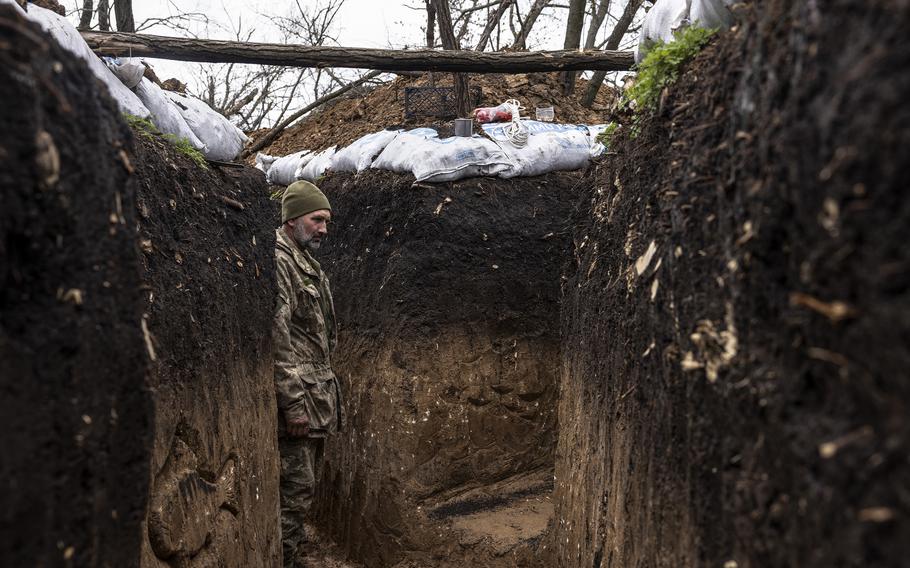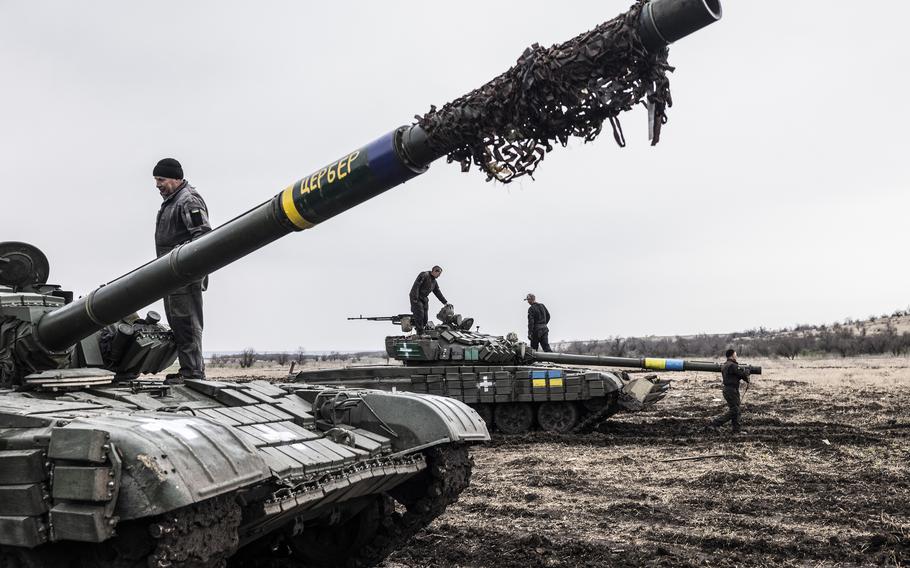Europe
Ukrainian forces probe front lines for Russian weak spots
The Washington Post April 12, 2023

Ukrainian soldiers carry the coffin of Vlad, 26, during his funeral at the military cemetery in Dnipro last week. (Heidi Levine/For The Washington Post )
DONETSK REGION, Ukraine — Even as they grapple with ammunition shortages and await materiel from Western backers, Ukrainian forces are testing Russian defenses for vulnerabilities ahead of a much-anticipated counteroffensive.
At one trench position just over a kilometer from Russian lines, a Ukrainian corporal is working with a partner unit flying commercial drones to monitor Russian forces, identify weak points and plan strikes to destroy fortifications.
“We are testing them,” he said, describing small operations aimed at identifying Russian fighting positions and measuring their response. “And of course, they are doing the same to us.” Like others in this report, the corporal spoke on the condition he be identified only by his rank and call sign, “Boxer,” in keeping with Ukrainian military regulations.
Boxer said the small operations are preparing his unit for a full-scale attack as they wait for more ammunition and heavier equipment. “It’s better not to allow [Russian troops] to dig themselves in so it will be easier for us to push them out,” he said.
The expected spring offensive has been framed as Ukraine’s make-or-break opportunity this year to recapture territory held by Russian forces, which totals about one-fifth of the country. But the operation has been delayed by weather, slow equipment deliveries and ammunition scarcities, fueling fears of a stalemate.
Further complicating the planned counterattack is the leak of dozens of U.S. military and intelligence documents, including many details about the condition of Ukraine’s military and its capabilities, including weaknesses in air defenses, that could force commanders to alter plans.
If Kyiv is unable to retake significant territory and the country’s Western backers flag, many Ukrainians worry they will be forced into negotiations with Russia from an unfavorable position.

A Ukrainian soldier in a trench in the eastern Donetsk region on Friday. (Heidi Levine/For The Washington Post)
The corporal in the Donetsk region has held the same trench position for over six months. “We got to know their voices,” he said of the Russian soldiers just over a kilometer away. “At night, we hear a lot of drunken screaming, mostly curse words.”
Stationed outside the town of Bakhmut, another commander described carrying out similar operations to test Russian defenses.
“We’ve seen newly mobilized [Russian] troops brought in just for digging, and they are reinforcing their positions very well,” said the 24-year-old captain with the call sign Metis who oversees the planning of operations and reconnaissance for his unit. “They are reinforcing with whatever they can find: wood, even trash.”
During one recent operation, drones were first used to identify mine fields on the Russian side before two small teams were sent in. “The results were much better than we planned; some of the soldiers shot back, but many abandoned their positions and weapons,” Metis said. The teams were able to push back a first line of Russian troops, but the Ukrainians did not advance and attempt to hold the position.
“Morale is low,” he said, explaining the desertions, “but that doesn’t mean all the Russian troops will preform like this. Their commanders are capable, but it looks like they can’t control their forces.”
He admitted that the success of the testing operations doesn’t mean his unit is ready for the full offensive. It is still waiting for more heavy equipment, armored vehicles to move large numbers of troops forward and more training.
When the unit first received an advanced antitank weapon system, troops trained themselves with the system manual and YouTube tutorials, he said.
“What I’m most concerned about are the anti-personnel mines. We can’t see them with our drones,” he said. During one operation, he said, they found the small explosives scattered all over a Russian defensive position. “There were even mines inside the trenches they were living in.”

Ukrainian forces during a training session with Soviet-era tanks in the Zaporizhzhia region last week. (Heidi Levine/For The Washington Post)
Western aid played a critical role in helping Ukrainian forces push back Russian troops from the northeastern Kharkiv region and parts of Kherson in the south last year. Since then, however, the battle slowed to a protracted grind, and it is unclear whether the additional support will be enough to break the stalemate. In some parts of occupied Ukraine, Russia has now dug in with heavily fortified defenses.
“Of course I’m worried, the longer we wait,” said a Ukrainian lieutenant colonel commanding a tank battalion in the Zaporizhzhia region, who goes by the call sign “Thunder.” Russian forces are “fortifying themselves more and more each day,” Thunder said.
Heavily mined front lines are expected to be a particularly difficult obstacle to navigate, he said. “There are mines on both sides of the front. We planted a lot of mines, and so did the Russian side.”
Despite their defensive posture, Ukrainian forces continue to take losses. The fight for Bakhmut has stretched into the longest and deadliest battle of the war, with steep casualties on each side.
At a recent mass funeral for Ukrainian soldiers in Dnipro, 14 coffins draped with the national flag were blessed by Orthodox priests before being buried.
“Eternal glory for the heroes, eternal glory to all those who gave their lives for the freedom of Ukraine,” one of the priests said during the service.
Vlad, a 26-year-old soldier, was killed when mortar rounds hit his position outside Bakhmut while he was digging a trench. His family asked that he be identified only by his first name because of security concerns.
“We were thrown into battle the first day after I joined,” said Vitalii, who served with Vlad and laid flowers on his grave. “I didn’t even know what unit I was in, it was so chaotic. Vlad was the first person I saw; I just followed him to know where to go.”
The two became close over nearly a year of fighting side by side. Vitalii said he was shocked when he heard how Vlad was killed. When the shelling began, Vlad didn’t run for cover like the others. “He must have been tired because I know he knew how to protect himself.”
“I know we have to fight this war, but I also know war isn’t the answer,” Vitalii said. “It’s just stupid.”
“Right now, I just feel exhausted,” he said, “and I remember Vlad saying he felt the same.”